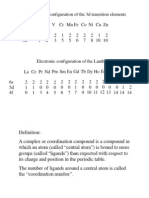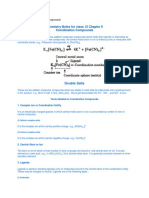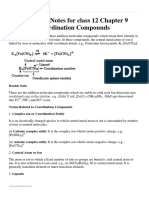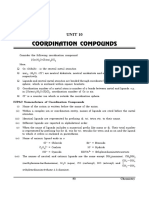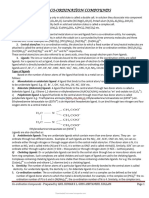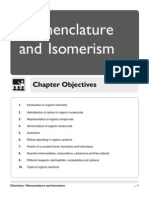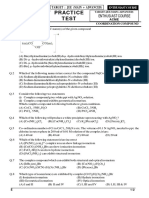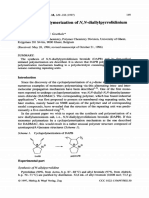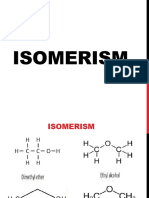Naming Coordination Compounds
Naming Coordination Compounds
Uploaded by
BLi'H'AbieeCopyright:
Available Formats
Naming Coordination Compounds
Naming Coordination Compounds
Uploaded by
BLi'H'AbieeOriginal Description:
Copyright
Available Formats
Share this document
Did you find this document useful?
Is this content inappropriate?
Copyright:
Available Formats
Naming Coordination Compounds
Naming Coordination Compounds
Uploaded by
BLi'H'AbieeCopyright:
Available Formats
Naming Coordination Compounds
A complex is a substance in which a metal atom or ion is associated with a group of neutral molecules or anions called ligands. Coordination compounds are neutral substances (i.e. uncharged) in which at least one ion is present as a complex. You will learn more about coordination compounds in the lab lectures of experiment 4 in this course. The coordination compounds are named in the following way. (At the end of this tutorial we have some examples to show you how coordination compounds are named.) A. To name a coordination compound, no matter whether the complex ion is the cation or the anion, always name the cation before the anion. (This is just like naming an ionic compound.) B. In naming the complex ion: 1. Name the ligands first, in alphabetical order, then the metal atom or ion. Note: The metal atom or ion is written before the ligands in the chemical formula. 2. The names of some common ligands are listed in Table 1.
For anionic ligands end in "-o"; for anions that end in "-ide"(e.g. chloride), "-ate" (e.g. sulfate, nitrate), and "-ite" (e.g. nirite), change the endings as follows: -ide -o; -ate ato; -ite -ito For neutral ligands, the common name of the molecule is used e.g. H2NCH2CH2NH2 (ethylenediamine). Important exceptions: water is called aqua, ammonia is called ammine, carbon monoxide is called carbonyl, and the N2 and O2 are called dinitrogen and dioxygen.
3. Greek prefixes are used to designate the number of each type of ligand in the complex ion, e.g. di-, tri- and tetra-. If the ligand already contains a Greek prefix (e.g. ethylenediamine) or if it is polydentate ligands (ie. can attach at more than one binding site) the prefixes bis-, tris-, tetrakis-, pentakis-, are used instead. (See examples 3 and 4.) The numerical prefixes are listed in Table 2. 4. After naming the ligands, name the central metal. If the complex ion is a cation, the metal is named same as the element. For example, Co in a complex cation is call cobalt and Pt is called platinum. (See examples 1-4). If the complex ion is an anion, the name of the metal ends with the suffix ate. (See examples 5 and 6.). For example, Co in a complex anion is called cobaltate and Pt is called platinate. For some metals, the Latin names are used in the complex anions e.g. Fe is called ferrate (not ironate). 5. Following the name of the metal, the oxidation state of the metal in the complex is given as a Roman numeral in parentheses. C. To name a neutral complex molecule, follow the rules of naming a complex cation. Remember: Name the (possibly complex) cation BEFORE the (possibly complex) anion.
For historic reasons, some coordination compounds are called by their common names. For example, Fe(CN)63 and Fe(CN)64 are named ferricyanide and ferrocyanide respectively, and Fe(CO)5 is called iron carbonyl.
Isomerism in Coordination Compounds
Two or more different compounds having the same formula are called isomers. Two principal types of isomerism are known among coordination compounds. Each of which can be further subdivided.
1. Stereoisomerism. a) Geometrical isomerism b) Optical isomerism 2. Structural Isomerism. a) Coordination isomerism b) Ionisation isomerism c) Hydrate isomerism d) Linkage isomerism
1. Stereoisomers
Stereoisomers have the same atoms, same sets of bonds, but differ in the relative orientation of these bonds.
Ignoring special cases involving esoteric ligands, then: Geometric isomers are possible for both square planar and octahedral complexes, but not tetrahedral. Optical isomers are possible for both tetrahedral and octahedral complexes, but not square planar. The earliest examples of stereoisomerism involve complexes of Co(III). In 1889, Jorgensen observed purple and green salts of [CoCl2(en)2]+, which Werner later correctly identified as the cis- and trans- geometric isomers. In 1911, the first resolution of optical isomers was reported by Werner and King for the complexes cis-[CoX(NH3)(en)2]2+, where X=Cl- or Br-.
Geometric Isomers
The number of geometric isomers expected for common stereochemistries are as follows:
Square Planar:
Compound type Ma2b2 Mabcd No. of isomers 2 (cis- and trans-) 3 (use cis- and trans- relations)
here a, b, c, and d refer to monodentate ligands.
A number of examples of these types have been isolated and characterised and they show very different chemical and biological properties. Thus for example, cis-PtCl2(NH3)2 is an anti-cancer agent (cisplatin) whereas the trans- isomer is inactive against cancer (it is toxic), and so not useful in Chemotherapy.
cis- and trans- isomers of [PtCl2(NH3)2] cis- and trans- refer to the position of 2 groups relative to each other. In the cisisomer they are "next to each other" i.e. at 90 degrees in relation to the central metal ion, whereas in the trans- isomer they are "opposite each other", i.e. at 180 degrees relative to the central metal ion.
a | | M ----b cis-
a----M----b trans-
3 geometric isomers of a square planar complex [PtBrClNH3(pyr)].
The first report of the three geometric isomers being isolated and characterised for complexes of the type [Mabcd] was by Il'ya Chernyaev in 1928. The example above was reported by Anna Gel'man in 1948.
Question. Does cis-amminebromo-cis-chloropyridineplatinum(II) uniquely identify isomer 9(ii)??
Octahedral:
Compound type No. of isomers Ma4b2 2 (cis- and trans-) Ma3b3 2 (fac- and mer-) MAA2b2 3 (2*cis- and 1 trans-) here a, and b, represent monodentate ligands and AA is a bidentate ligand.
In the second example, new labels are introduced to reflect the relative positions of the ligands around the octahedral structure. Thus; placing the 3 groups on one face of the octahedral gives rise to the facial isomer and placing the 3 groups around the centre gives rise to the meridional isomer.
fac- and mer- isomers of [RhCl3(pyr)3]. [Mabcdef] is expected to give 15 geometric isomers. In the case of [PtBrClI(NH3) (pyr)NO2], several of these were isolated and characterised by Anna Gel'man and reported in 1956. Optical isomers are possible for each of these 15 forms, making a total of 30 isomers.
The cis- isomer of MAA2b2 may also exhibit optical isomerism (see Figure 12) although we will concentrate largely on optical isomers of the type M(AA)3 (see below).
Optical Isomers
Optical isomers are related as non-superimposable mirror images and differ in the direction with which they rotate plane-polarised light. These isomers are referred to as enantiomers or enantiomorphs of each other and their non-superimposable structures are described as being asymmetric. Various methods have been used to denote the absolute configuration of optical isomers such as R or S, or or C and A. The IUPAC rules suggest that for general octahedral complexes C/A scheme is convenient to use and that for bis and tris bidentate complexes the absolute configuration be designated Lambda (left-handed) and Delta (right-handed). Priorities are assigned for mononuclear coordination systems based on the standard sequence rules developed for enantiomeric carbon compounds by Cahn, Ingold and Prelog (CIP rules). These rules use the coordinating atom to arrange the ligands into a priority order such that the highest atomic number gives the highest priority number (smallest CIP number). For example the hypothetical complex [Co Cl Br I NH3 NO2 SCN]2- would assign the I- as 1, Br as 2, Cl as 3, SCN as 4, NO2 as 5 and NH3 as 6.
Here is one isomer where the I and Cl, and Br and NO2 were found to be trans- to each other.
The reference axis for an octahedral centre is that axis containing the ligating atom of CIP priority 1 and the trans ligating atom of lowest possible priority (highest numerical value). The atoms in the coordination plane perpendicular to the reference axis are viewed from the ligand having that highest priority (CIP priority 1) and the clockwise and anticlockwise sequences of priority numbers are compared. The structure is assigned the symbol C or A, according to whether the clockwise (C) or anticlockwise (A) sequence is lower at the first point of difference. In the example shown above this would be C.
The two optical isomers of [Co(en)3]3+ have identical chemical properties and just denoting their absolute configuration does NOT give any information regarding the direction in which they rotate plane-polarised light. This can ONLY be determined from measurement and then the isomers are further distinguished by using the prefixes (-) and (+) depending on whether they rotate left or right. To add to the confusion, when measured at the sodium D line (589nm), the tris(1,2diaminoethane)M(III) complexes (M= Rh(III) and Co(III)) with IDENTICAL absolute configuration, rotate plane polarised light in OPPOSITE directions! The left-handed ()-[Co(en)3]3+ isomer gives a rotation to the right and therefore corresponds to the (+) isomer. Since the successful resolution of an entirely inorganic ion (containing no C atoms) (hexol) only a handful of truly inorganic complexes have been isolated as their optical isomers e.g. (NH4)2Pt(S5)3.2H2O. For tetrahedral complexes, R and S would be used in a similar method to tetrahedral Carbon species and although it is predicted that tetrahedral complexes with 4 different ligands should be able to give rise to optical isomers, in general they are too labile and can not be isolated.
2. Structural Isomers
There are several types of this isomerism frequently encountered in coordination chemistry and the following represents some of them.
a) Coordination isomerism: where compounds containing complex anionic and cationic parts can be thought of as occurring by interchange of some ligands from the cationic part to the anionic part.
one isomer [Co(NH3)6] [Cr(C2O4)3] another isomer [Co(C2O4)3] [Cr(NH3)6]
b) Ionisation isomers: where the isomers can be thought of as occurring because of the formation of different ions in solution.
one isomer [PtBr(NH3)3]NO2 -> NO2- anions in solution another isomer [Pt(NO2)(NH3)3]Br -> Br- anions in solution
Notice that both anions are necessary to balance the charge of the complex, and that they differ in that one ion is directly attached to the central metal but the other is not. A very similar type of isomerism results from replacement of a coordinated group by a solvent molecule (Solvate Isomerism). In the case of water, this is called Hydrate isomerism.
c) Hydrate isomerism: the best known example of this occurs for chromium chloride "CrCl3.6H2O" which may contain 4, 5, or 6 coordinated water molecules.
[CrCl2(H2O)4]Cl.2H2O bright-green [CrCl(H2O)5]Cl2.H2O grey-green [Cr(H2O)6]Cl3 violet These isomers have very different chemical properties and on reaction with AgNO3 to test for Cl- ions, would find 1, 2, and 3 Cl- ions in solution respectively.
d) Linkage isomerism occurs with ambidentate ligands. These ligands are capable of coordinating in more than one way. The best known cases involve the monodentate ligands SCN- / NCS- and NO2- / ONO-.
For example: [Co(ONO)(NH3)5]Cl the nitrito isomer -O attached [Co(NO2)(NH3)5]Cl the nitro isomer - N attached.
Inorganic Nomenclature
As part of this course, you are required to make yourselves familiar with the rules related to Inorganic Nomenclature.
Uses of Coordination Compounds
A brief survey of some of the uses of coordination compounds includes:
l. Dyes and Pigments: Coordination compounds have been used from the earliest times as dyes and pigments, for example madder dye which is red, was used by the ancient Greeks and others. It is a complex of Hydroxyanthraquinone. A more modern example is the pigment copper phthalocyanine, which is blue. 2. Analytical Chemistry: You have already encountered many such uses during the laboratory course.
(a) Colour Tests: Since many complexes are highly coloured they can be used as colourimetric reagents e.g. formation of red 2,2'-bipyridyl and l,l0-phenanthroline complexes as a test for Fe(II) (b) Gravimetric Analysis: Here chelating ligands are often used to form insoluble complexes e.g. Ni(DMG)2 and Al(oxine)3 (see laboratory manual).
(c) Complexometric Titrations and Masking Agents: An example of this is the use of EDTA in the volumetric determination of a wide variety of metal ions in solution, e.g. Zn2+, Pb2+, Ca2+,Co2+, Ni2+, Cu2+, etc. By careful adjustment of the pH and using suitable indicators, mixtures of metals can be analysed, e.g. Bi3+ in the presence of Pb2+ (see laboratory manual). Alternatively, EDTA may be used as a masking agent to remove a metal ion which would interfere with the analysis of a second metal ion present.
3. Sequestering Agents: Related to their use as masking agents is the use of ligands for "sequestering" i.e. for the effective removal of objectionable ions from solution in industrial processing, e.g. EDTA is used to "soften" water. The addition of EDTA to water is used in boilers etc., to prevent "scaling" or build up of insoluble calcium salts. 4. Extraction of Metals: Sometimes certain metals can be leached from their ores by formation of stable complexes e.g. Ag and Au as complexes of cyanide ion. 5. Bio-Inorganic Chemistry: Naturally occurring complexes include haemoglobin, chlorophyll, vitamin B12 etc. EDTA and other complexing agents have been used to speed the elimination of harmful radioactive and other toxic elements from the body. (e.g. Pb2+). In these cases soluble metal chelate complexes are formed. 6. Chemo-therapy: an example here is the use of cis-PtCl2(NH3)2 as an anti-tumour drug.
You might also like
- Coordination Chemistry Module 1Document35 pagesCoordination Chemistry Module 1Praveen PradeepNo ratings yet
- Organic Chemistry Help! Practice Exam Window For Xula-O1e2Document7 pagesOrganic Chemistry Help! Practice Exam Window For Xula-O1e2Kristia Stephanie BejeranoNo ratings yet
- Isomerism in Coordination Compounds: 1. StereoisomersDocument6 pagesIsomerism in Coordination Compounds: 1. StereoisomersAs if Ali LarikNo ratings yet
- Haloareans and Halo AlkanesDocument23 pagesHaloareans and Halo Alkanesthinkiit100% (1)
- Coordination CompoundDocument24 pagesCoordination CompoundAnsari SameerNo ratings yet
- Co-Ordination CompoundsDocument11 pagesCo-Ordination CompoundsShashank AgarwalNo ratings yet
- 6 2018 11 10!08 18 38 PMDocument9 pages6 2018 11 10!08 18 38 PMAlma Tyara SNo ratings yet
- New Microsoft Word DocumentDocument7 pagesNew Microsoft Word DocumentNoor AlamNo ratings yet
- CH 9Document13 pagesCH 9Tr Mazhar PunjabiNo ratings yet
- Coordination Compounds IDocument58 pagesCoordination Compounds IAli Muhammad Kamba60% (5)
- 12 Chemistry Impq CH07 The P Block Elements 03Document15 pages12 Chemistry Impq CH07 The P Block Elements 03Ricky SharmaNo ratings yet
- Isomerism Coordination ChemistryDocument9 pagesIsomerism Coordination ChemistryLala NurfalahNo ratings yet
- Transition Metal ComplexesDocument103 pagesTransition Metal Complexesidownloadbooksforstu100% (1)
- 1_Coordination_CompoundsDocument13 pages1_Coordination_CompoundsDeekshithNo ratings yet
- 2Document44 pages2hansanihereshika1999No ratings yet
- Chemistry Notes For Class 12 Chapter 9 Coordination CompoundsDocument64 pagesChemistry Notes For Class 12 Chapter 9 Coordination CompoundsGaurav YadavNo ratings yet
- R K Sharma Coordination Chemistry 10-30Document23 pagesR K Sharma Coordination Chemistry 10-30Kamal KishoreNo ratings yet
- Self-Learning Activity On Coordination CompoundsDocument5 pagesSelf-Learning Activity On Coordination CompoundsAbigail CalalangNo ratings yet
- 9 Coordinaton Compounds NewDocument11 pages9 Coordinaton Compounds NewShesha krishnaNo ratings yet
- Chem261 Part 1-A and BDocument33 pagesChem261 Part 1-A and BAriana NaidooNo ratings yet
- Chemistry Notes For Class 12 Chapter 9 Coordination CompoundsDocument14 pagesChemistry Notes For Class 12 Chapter 9 Coordination CompoundsRajeev Kaushik100% (5)
- ComplexesDocument20 pagesComplexespunt3yNo ratings yet
- Module 1 Coordination CompoundsDocument64 pagesModule 1 Coordination CompoundsPreetika GuptaNo ratings yet
- Coordination NumberDocument11 pagesCoordination NumberSyed Qasim Shah100% (2)
- Complex Compounds NotesDocument14 pagesComplex Compounds Notesjyothi sai sriNo ratings yet
- Co-Ordination CompoundsDocument10 pagesCo-Ordination CompoundsTr Mazhar PunjabiNo ratings yet
- Isomerism IN Compounds: CoordinationDocument19 pagesIsomerism IN Compounds: CoordinationEmilyNo ratings yet
- Nomenclature of 6 - 2018 - 11 - 04!09 - 13 - 23 - PMDocument9 pagesNomenclature of 6 - 2018 - 11 - 04!09 - 13 - 23 - PMnoor ul ainNo ratings yet
- Unit 24 - For PetrolDocument46 pagesUnit 24 - For PetrolYaman EkinciNo ratings yet
- 1CHEM261 Part1A WVZDocument30 pages1CHEM261 Part1A WVZndlovumpendulo281No ratings yet
- Komlexemaster 7 SemDocument49 pagesKomlexemaster 7 SemRaheem SimsNo ratings yet
- Coordination Compounds Class 12Document112 pagesCoordination Compounds Class 12nm.ananya2008100% (1)
- Coordination Compounds - BSC IIIDocument14 pagesCoordination Compounds - BSC IIIRojo John0% (1)
- Chemistry Notes For Class 12 Chapter 9 Coordination CompoundsDocument14 pagesChemistry Notes For Class 12 Chapter 9 Coordination CompoundsAman KumarNo ratings yet
- Chemistry Notes For Class 12 Chapter 9 Coordination CompoundsDocument11 pagesChemistry Notes For Class 12 Chapter 9 Coordination CompoundsYASH SONARNo ratings yet
- Chemistry Formula Chapter9 Coordination CompoundsDocument15 pagesChemistry Formula Chapter9 Coordination CompoundsJeshanth JsNo ratings yet
- Unit 9.coordination CompoundsDocument14 pagesUnit 9.coordination Compoundslitty0631No ratings yet
- NOTES - COORDINATION COMPOUNDSDocument12 pagesNOTES - COORDINATION COMPOUNDScri12345josephNo ratings yet
- Coordination ChemistryDocument10 pagesCoordination ChemistryChahek KalraNo ratings yet
- Chemistry Notes For Class 12 Chapter 9 Coordination CompoundsDocument14 pagesChemistry Notes For Class 12 Chapter 9 Coordination CompoundsHarry RoyNo ratings yet
- Coordination Chemistry Structures and IsomersDocument272 pagesCoordination Chemistry Structures and Isomersد.حاتممرقهNo ratings yet
- Chemistry-Ch 4 - Chemical Formulae and EquationDocument3 pagesChemistry-Ch 4 - Chemical Formulae and EquationHassan RiazNo ratings yet
- Coordination Compounds:: CationDocument34 pagesCoordination Compounds:: Cationhansanihereshika1999No ratings yet
- Coordination CompoundDocument11 pagesCoordination Compoundkanav8e.32280No ratings yet
- Chemistry - Transition MetalsDocument46 pagesChemistry - Transition Metalsshan mackNo ratings yet
- Notes Coordination CompletedDocument24 pagesNotes Coordination CompletedRoshini VivekanandanNo ratings yet
- Coordination Complex: From Wikipedia, The Free EncyclopediaDocument21 pagesCoordination Complex: From Wikipedia, The Free EncyclopediaHasnain Mohammad HanifNo ratings yet
- Chapter 9 11Document15 pagesChapter 9 11Ritik KumarNo ratings yet
- Coordin PDFDocument5 pagesCoordin PDFBhupinder AroraNo ratings yet
- Coordination Compounds NotesDocument10 pagesCoordination Compounds Notesmrdeadshot0987No ratings yet
- Coordination Compound. Inorganic ChemistryDocument14 pagesCoordination Compound. Inorganic ChemistryPragyan ChutiaNo ratings yet
- Geometric Isomers Isomers That Differ in The Way The Ligand Is Bound To The Optical Isomers Isomers That Do Not Have Symmetry and Are NotDocument20 pagesGeometric Isomers Isomers That Differ in The Way The Ligand Is Bound To The Optical Isomers Isomers That Do Not Have Symmetry and Are NotSahadath JameelNo ratings yet
- Isomerism in Coordination CompoundDocument14 pagesIsomerism in Coordination CompoundPragyan ChutiaNo ratings yet
- Activity 22: Monodentate One With Two Such Atoms Is Bidentate, One With Three Such Atoms Is Tridentate, EtcDocument8 pagesActivity 22: Monodentate One With Two Such Atoms Is Bidentate, One With Three Such Atoms Is Tridentate, EtcAhmed MahmoudNo ratings yet
- Nomenclature & Isomerism (1-77)Document77 pagesNomenclature & Isomerism (1-77)deepakkr08088% (8)
- Stereoisomers Part 1Document14 pagesStereoisomers Part 1Mabelle DucusinNo ratings yet
- Coordchem1j PDFDocument90 pagesCoordchem1j PDFVedanti BangarNo ratings yet
- Co Ordination CompoundsDocument17 pagesCo Ordination Compoundsmrsimmortal49No ratings yet
- Why Are Chemicals Not Named John? Naming Chemical Compounds 6th Grade | Children's Chemistry BooksFrom EverandWhy Are Chemicals Not Named John? Naming Chemical Compounds 6th Grade | Children's Chemistry BooksNo ratings yet
- Inverse Coordination Chemistry: A Novel Chemical Concept: Academic PrimersFrom EverandInverse Coordination Chemistry: A Novel Chemical Concept: Academic PrimersNo ratings yet
- Isomerism DPPDocument20 pagesIsomerism DPPrashmi.maugustineNo ratings yet
- Geometrical Isomerism Copy - UnlockedDocument22 pagesGeometrical Isomerism Copy - Unlockedsamarthafc1No ratings yet
- Organic Chemistry Solutions for ICSE Board Class 10 Science (Concise - Selina Publishers)Document74 pagesOrganic Chemistry Solutions for ICSE Board Class 10 Science (Concise - Selina Publishers)haseebmuhammed786687No ratings yet
- Stereochemistry PartiiDocument23 pagesStereochemistry PartiiSharath PavanNo ratings yet
- Lecture 15Document8 pagesLecture 15Aravindan NatarajanNo ratings yet
- G12 NCERT Unit10 Haloalkenes-and-Haloarenes FinalDocument51 pagesG12 NCERT Unit10 Haloalkenes-and-Haloarenes FinalGamers prideNo ratings yet
- StereochemistryDocument39 pagesStereochemistryNiravNo ratings yet
- Organic Chemistry I MCQDocument37 pagesOrganic Chemistry I MCQelsiesaveena96No ratings yet
- BAS 202 Important Questions With Solutions 2023-24Document28 pagesBAS 202 Important Questions With Solutions 2023-24satyam.23gcebcsh047No ratings yet
- Boardworks IBO Chemistry Diploma A-Level Mapping GridDocument28 pagesBoardworks IBO Chemistry Diploma A-Level Mapping GridMary MannuNo ratings yet
- Chapter 4 Carbon and Molecular Diversity of LifeDocument2 pagesChapter 4 Carbon and Molecular Diversity of LifeMohammad Mahrus Bin AshfaqNo ratings yet
- Pericyclic Reactions and Organic Photochemistry S. Sankararaman Department of Chemistry (PDFDrive)Document34 pagesPericyclic Reactions and Organic Photochemistry S. Sankararaman Department of Chemistry (PDFDrive)uvir iitm67% (3)
- IsomerismDocument57 pagesIsomerismrajeshwariNo ratings yet
- Experiment 17B Lab ReportDocument3 pagesExperiment 17B Lab ReportMikey ZhitnitskyNo ratings yet
- Get Get ready for organic chemistry Karty free all chaptersDocument65 pagesGet Get ready for organic chemistry Karty free all chaptersladhabalbipv100% (4)
- 4th SEM PCI SYLLABUSDocument20 pages4th SEM PCI SYLLABUSDAMBALE100% (1)
- PS # 18 Coordination CompoundDocument2 pagesPS # 18 Coordination CompoundanirudhsingotyiaNo ratings yet
- Chemistry For IIT PreparationDocument82 pagesChemistry For IIT PreparationApex Institute50% (4)
- Isomerism: Definition-Structural Isomers: Same Molecular Formula Different Structures (Or Structural Formulae)Document13 pagesIsomerism: Definition-Structural Isomers: Same Molecular Formula Different Structures (Or Structural Formulae)Trần Duy Tân100% (2)
- Síntese e Polimerização de Brometo de N, N - DialilpirrolidínioDocument8 pagesSíntese e Polimerização de Brometo de N, N - DialilpirrolidínioHeloisa Gabriele Miranda da SilvaNo ratings yet
- Chiral CompoundsDocument20 pagesChiral CompoundsShubham RampalliwarNo ratings yet
- Gen Chem Module Q2Week 7 8Document23 pagesGen Chem Module Q2Week 7 8Dan MacabingilNo ratings yet
- Science Question PaperDocument7 pagesScience Question Paperamogh biyalNo ratings yet
- IsomerismDocument14 pagesIsomerismAruna SriNo ratings yet
- CHEMLEC ReviewerDocument6 pagesCHEMLEC ReviewerアーロンクリスチャンNo ratings yet
- Presentation 1Document60 pagesPresentation 1Mezgebu BiresawNo ratings yet
- Monarch Butterfly: Bilateral Symmetry Mirror SymmetryDocument29 pagesMonarch Butterfly: Bilateral Symmetry Mirror SymmetryElena Iulia CucoleaNo ratings yet
- Chapter 16Document52 pagesChapter 16YonnaFebriaNingsihNo ratings yet






























